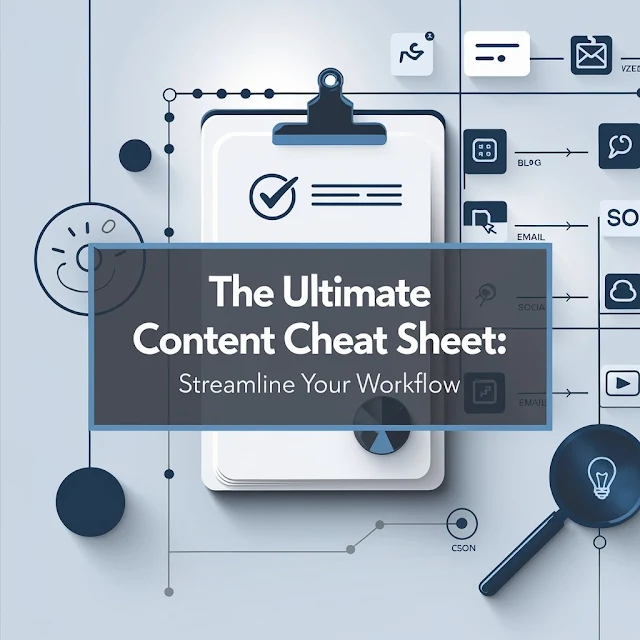Creating high-quality content that resonates with your audience and drives results can feel overwhelming. But what if you had a simple, actionable guide to streamline the process? Enter the Content Cheat Sheet—a quick-reference tool designed to help you create consistent, engaging, and effective content every time.
Whether you're crafting blog posts, social media updates, email campaigns, or videos, this cheat sheet will save you time, boost your productivity, and ensure your content aligns with your goals. Let’s dive in!
What is a Content Cheat Sheet?
A content cheat sheet is a concise, easy-to-follow guide that outlines best practices, tips, and templates for creating specific types of content. It’s your go-to resource for maintaining consistency, improving quality, and avoiding common mistakes.
Think of it as a roadmap that helps you stay on track while creating content that engages your audience and achieves your objectives.
Why You Need a Content Cheat Sheet
Saves Time: No more starting from scratch—use the cheat sheet as a template for every piece of content.
Ensures Consistency: Keeps your content aligned with your brand voice, style, and goals.
Improves Quality: Acts as a checklist to ensure you don’t miss key elements like SEO optimization or CTAs.
Boosts Productivity: Helps you create content faster and more efficiently.
Key Elements of a Content Cheat Sheet
Here’s what your cheat sheet should include, depending on the type of content you’re creating:
1. General Content Creation
Target Audience: Define your audience’s demographics, pain points, and interests.
Tone and Voice: Establish guidelines for your brand voice (e.g., professional, casual, friendly).
SEO Basics: Include keyword research, meta descriptions, and alt text tips.
Content Structure: Use headings, subheadings, bullet points, and short paragraphs for readability.
Call-to-Action (CTA): Add clear and compelling CTAs to guide your audience.
 |
| "🚀 Boost your content creation process with the ultimate cheat sheet! Perfect for bloggers, marketers, and content creators. #ContentCreation #ContentMarketing #SEO" |
2. Blog Posts
Headline Formulas: Use templates like “How to [Achieve X] in [Time]” or “X Tips for [Solving Y Problem].”
Introduction Tips: Hook readers in the first 100 words with a question, statistic, or bold statement.
Content Length: Aim for 1,000–2,000 words for in-depth articles, depending on your niche.
Internal Linking: Link to relevant pages on your site to improve SEO and user experience.
Editing Checklist: Check for grammar, readability, and proper formatting before publishing.
3. Social Media Content
Platform-Specific Guidelines: Optimize post length, image sizes, and hashtags for each platform (e.g., Instagram, Twitter, LinkedIn).
Posting Frequency: Post consistently—3–5 times per week on most platforms.
Engagement Tips: Write captions that encourage likes, comments, and shares.
Visual Content: Use eye-catching graphics, videos, and branded templates.
4. Email Marketing
Subject Line Formulas: Use curiosity-driven or benefit-focused subject lines (e.g., “You Won’t Believe This Offer!”).
Email Length: Keep promotional emails short and newsletters more detailed.
Personalization Tips: Use merge tags and segmentation to address recipients by name.
CTA Placement: Place CTAs above the fold and at the end of the email.
5. Video Content
Script Structure: Outline your video with an intro, main content, and outro.
Lighting and Audio Tips: Use natural lighting and a good microphone for clear audio.
Editing Checklist: Add captions, transitions, and branding elements.
Platform-Specific Tips: Adjust video length and format for YouTube, TikTok, Instagram, etc.
6. SEO Content
Keyword Placement: Include keywords in the title, headers, and first 100 words.
Meta Descriptions: Write compelling meta descriptions under 160 characters.
Image Optimization: Use descriptive file names, alt text, and compressed images.
Backlink Strategies: Earn backlinks by guest posting and collaborating with influencers.
How to Create Your Own Content Cheat Sheet
Identify Your Goals: What do you want to achieve with your content? (e.g., traffic, engagement, leads).
Choose Your Content Types: Focus on the formats you use most often (e.g., blogs, social media, emails).
Outline Best Practices: Research and compile tips, templates, and examples for each content type.
Organize It: Use headings, bullet points, and visuals to make your cheat sheet easy to scan.
Update Regularly: Keep your cheat sheet up-to-date with the latest trends and tools.
Note:
Final Thoughts
A content cheat sheet is more than just a tool—it’s your secret weapon for creating high-quality content that drives traffic, engages your audience, and grows your brand. Whether you’re a beginner or a seasoned pro, having a cheat sheet on hand will make your content creation process faster, easier, and more effective.
Ready to create your own? Start today and watch your content game soar! 🚀
